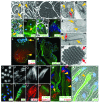Drosophila spermiogenesis: Big things come from little packages
- PMID: 23087837
- PMCID: PMC3469442
- DOI: 10.4161/spmg.21798
Drosophila spermiogenesis: Big things come from little packages
Abstract
Drosophila melanogaster spermatids undergo dramatic morphological changes as they differentiate from small round cells approximately 12 μm in diameter into highly polarized, 1.8 mm long, motile sperm capable of participating in fertilization. During spermiogenesis, syncytial cysts of 64 haploid spermatids undergo synchronous differentiation. Numerous changes occur at a subcellular level, including remodeling of existing organelles (mitochondria, nuclei), formation of new organelles (flagellar axonemes, acrosomes), polarization of elongating cysts and plasma membrane addition. At the end of spermatid morphogenesis, organelles, mitochondrial DNA and cytoplasmic components not needed in mature sperm are stripped away in a caspase-dependent process called individualization that results in formation of individual sperm. Here, we review the stages of Drosophila spermiogenesis and examine our current understanding of the cellular and molecular mechanisms involved in shaping male germ cell-specific organelles and forming mature, fertile sperm.
Figures


References
-
- Tates AD. Cytodifferentiation during spermatogenesis in Drosophila melanogaster: An electron microscope study. Leiden: Rijksuniversiteit, 1971.
LinkOut - more resources
Full Text Sources
Molecular Biology Databases
